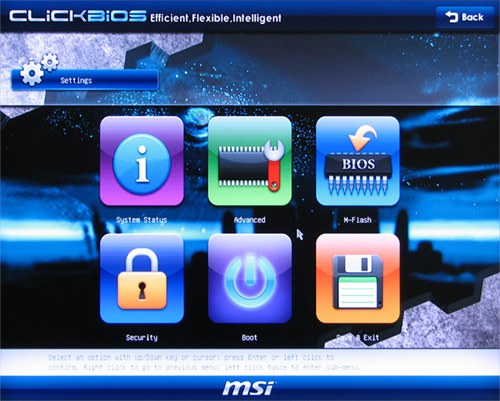UEFI
The new motherboard lineup from MSI features a graphical UEFI, so we'll just briefly repeat what we stated in the review of ASUS P8P67 Deluxe: a regular user doesn't have to use BIOS setup at all. Well, maybe except for just a few things. So creating a whole new GUI for that doesn't look reasonable.
The more so because MSI's interface is, well, see for yourself.

 Main and settings windows
Main and settings windows
That is surely not ASCII graphics, with all that animation and whatnot. But it's too much. Makes you wonder why there isn't a circus march playing in the background. Well, that's just our opinion, but what about meager functionality? Compare it with ASUS's version. Let's see a few settings screens.
This might not be a perfect screenshot, but the whole color scheme is not quite readable. Again, that of ASUS is better ergonomically. Also, the mouse pointer was flickering and even fluttering a bit for some reason, so double-clicking didn't always work (we tried a couple of regular cabled USB mice). Of course, none of that is a critical drawback, but they could've put more effort into functionality instead of fancy visuals. But we doubt MSI will change the ClickBIOS concept, because it's shared by all company's experiments with EFI.
Additional features include utilities (backup, search the Internet for a newer BIOS, custom bootup screens and memory test) and a few simple games. Running any of these, except for the memory test, requires corresponding BIOS modules present on the supplied DVD. This all looks like an EFI tech demo. It's hard to imagine a user who would reboot PC just to play a few games in BIOS.
The bottom line is: MSI's current UEFI is a purely marketing solution. Little or no effort has been made to use advanced GUI capabilities and mouse support to offer users a new way of managing BIOS options. It hasn't become any more convenient or readable. And no, the motherboard doesn't boot up faster.
Anyway, BIOS allows you to save and restore profiles, boot PC using a firmware image stored on a USB drive (that's an innovation from MSI), upgrade firmware from a flash or other drive (M-Flash), and quickly choose bootable drive without changing any settings. Overclocking parameters are typical to what we've seen so far: you can adjust multipliers for each core in the Turbo Boost mode (Limited Unlocked) as well as for all cores at once in the regular mode, if you have a K-series CPU. There are regular thermal envelope controls: you can set desired TDP and maximum 'overshoot,' as well as an average time lapse used to calculate consumed energy (up to 32 seconds; the longer it is, the longer a CPU can have the above-threshold TDP). Overclocking enthusiasts will also be able to change CPU reference frequency in 0.07 MHz increments. If you're not one, we recommend that you leave it alone.
Write a comment below. No registration needed!
